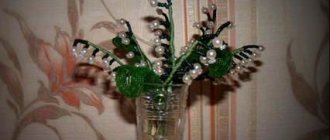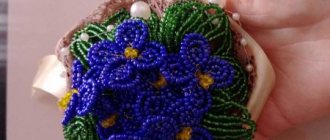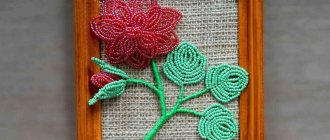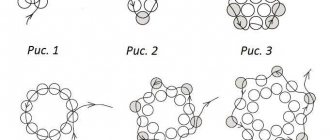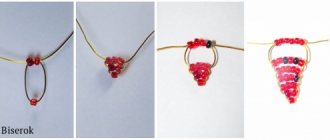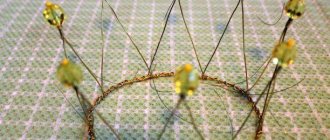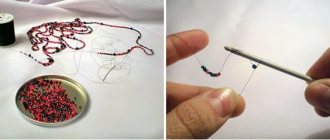Natural flowers are wonderful, but they have one small drawback: they cannot please a person with their flowering all year round. An excellent alternative is to make a flower from beads.
It does not require constant care and, in principle, is not whimsical. There are a large number of flower weaving patterns on the Internet. In this article we will talk about making an orchid from beads with your own hands.
Materials needed to make an orchid
Standard set of materials required for weaving:
- Beads, different colors.
- Decorations.
- Thread for weaving from beads.
- Beading needle.
- Regular threads.
- Glue.
- Scissors.
- Pot.
- Alabaster or plaster.
It is worth remembering that a properly designed place to work will significantly speed up the process.
Meaning of colors
Before answering the question of how to make an orchid from beads, you need to understand the meaning of a flower of a particular color:
- White color symbolizes love.
- Red color awakens the desire to create.
- Blue orchid signifies spiritual connection and friendship. Makes an ideal gift for parents.
- Yellow color brings joy.
Video lesson:
Blue orchid
You are offered a master class on creating beaded flowers. Each orchid flower contains several types of petals. The main ones are made 4.5 cm long with blue and transparent beads. Four turns are made around the base. There are three petals in total. The two larger leaves have five arches around the middle.
Their length is the same - 4.5 cm, but the shape is more rounded. The largest petal is made of beads of two colors - blue and white, which are located around the base in seven rows. The core of the flower is a large white bead and a petal made of four arcs of white beads.
Weaving
This section will discuss a step-by-step master class on weaving an orchid from beads.
Leaves
You need to weave 10 leaves: 4 small leaves, 7 centimeters long, 3 medium leaves, 9 centimeters long, 3 large leaves, 9 centimeters long. The increase occurs due to the addition of arcs.
- A 20 centimeter wire is taken and a small ring is made at one end.
- 20, 25 and 30 green beads are strung on a wire.
- Then the remaining beads are collected onto the working end. Turns are made from it around the main axis, in total there should be 6 turns on each leaf.
- After completing each revolution, it is necessary to connect the row with the main axis using a wire. The connecting wire should be smaller than the main wire.
- After turning and securing the last row to the axis, the end of the remaining wire is hidden, and its excess is cut off.
- The rest of the leaves are made in the same way.
Little bud
- A thin wire is taken and three green beads are placed on it. The other end is wrapped around the wire to secure them. Then we make two turns around with 10 and 18 beads.
- The second petal is made in the same way.
- The bead is placed on the wire of both petals and hidden in the middle between the petals.
- You need to weave 2 more buds.
Big bud
The large bud is made of green, white and pink beads. Colors are taken randomly.
- According to the algorithm described above, only with three turns, not two, petals are made. The proportion of different colors of beads is at the discretion of the master.
- From the upper end of the petals you need to leave 5-7 centimeters of wire and connect the petals to each other using them.
- A bead is placed on the resulting axis of 3 petals and covered with petals.
- The petals curl together.
- You need to weave 2 more of these buds.
Stamen
- A large bead and 26 yellow beads are placed on the wire.
- The ends of the wire must be wound together 3 times at the base of the bead.
- Then 5 beads are placed on both ends.
- Then 21 beads are placed on them and a loop is made. The pestle is ready.
- 4 yellow beads are placed on the wire and a round loop is made from them. Then you need to make another turn around. The ear is ready.
- In total you need to make 7 pestles and 14 ears.
Flowers
- 6 white beads are strung on a wire.
- The working thread makes one turn around 17 white beads. Then another 4 turns are made with a constant increase in the number of beads. The excess wire is cut off and the ends are hidden. The round leaf is ready.
- 8 beads are placed on the base (you need to take beads of several red and pink shades).
- The first turn of 23 beads is made. Then 1 more bead is placed on the main end. In total, you need to make 4 such turns with a constant increase in the number of beads. With these extra beads you can create a sharp petal.
- To make the tongue you will need two shades of red. 3 beads are placed on the wire. One turn of 7 beads is made. Then 3 more circles with increasing intensity.
- The center is slightly pressed inward to give the shape of a petal.
- In total, you need to make 7 reeds, 14 sharp and 21 round petals.
- 2 round and 2 sharp petals are combined from a pair and connected to each other.
How to do it right
To weave an orchid beads of different colors and sizes are used , wire to match the color of the beads, beads, floss threads or floral ribbons for wrapping the wire.
Beaded orchid weaving pattern
To create an orchid you will need beads of five colors, white beads, multi-colored wire, wire cutters, glue, plaster and a pot. The bead weaving pattern for beginners contains detailed photos and descriptions of this creation.
We weave leaves
- Take the leaf wire and bend the end so that the beads do not “run away”.
- Place green beads on the axle. Adjust the axle length yourself.
- Then bend the wire at the other end.
- Place the remaining green beads on a thin wire.
- Wrap the beaded wire once around the base of the axle. Move the beads along the entire axis, making a turn at the top, and go down. Make one more turn.
- Visually divide the leaf into three parts and place two thin wires on top.
- We wrap each arc with wire and move them tightly towards each other.
- We also sew all subsequent arcs with beads.
- We sew five rows.
- When you make the last circle, you need to cut the end of the wire.
- And we collect the next beads on two wires at once.
- We fasten the wire on both sides.
- Then open the ring at the top of the sheet and gently pull the wire down to hide it under the weave.
- Thus, make several leaves of the desired length and width.
buds
- Using the same wire that was used to make the arches of the leaf, we create a loop and collect 3 beads.
- We make 2 arcs on each side.
- Then we put a bead on both axes.
- We hide the bead inside and fold the leaves.
- We twist the wire around the axis. We make several of these buds.
We weave multi-colored large buds
We use beads of different colors.
- For each bud, 3 arcs are made. For each bud, collect at least 5 beads along the axis.
- Fold the petals and twist the wire.
- We lower the bead inside and give the bud a rounded shape. Close and twist the wire.
We make flowers
- We weave round petals. Make a loop 7 cm long, twist it and collect 6 beads.
- We put beads on the other edge of the wire and secure it at the end.
- We make the next 5 arcs.
- We pass the remaining wire along the axis and cut it off.
- Now we make sharp petals. Mix several shades of beads and place any 8 pieces on the base of the wire.
- We string the required amount of beads and make arcs, not forgetting to add an additional bead before making each row. This will make the petal sharp.
- Make 2 of these leaves for each flower.
- We place the round leaf on the sharp one at an angle of 45 degrees and fold the second part of the flower in a mirror image.
- To make a stamen, string beads onto a wire and move them to the edge.
- We put a bead on the wire and fasten it.
- We move several beads closer to the bead. Then we move the beads further, make a loop and bend it to the bead.
- Fix by twisting.
- We connect two wires together.
- There will be two “ears” on each side of the pestle. To make them, collect 4 beads and twist them. We make one more arc.
- We make the tongue of the bud. Make a loop, twist and collect 3 beads. Let's make a circle.
- Raise the axes and make several rows, obtaining a rounded shape.
- You will need one reed for each flower.
- Now we attach the pestle to the tongue so that the bead is in the middle.
- We frame it with “ears”.
- We attach a leaf above the core.
- We attach the side double petals.
- We wrap the wire on all the flowers with green floss threads. Apply a drop of glue to the thread on both sides.
- We wrap all the details of the flower.
- Imagine what your beaded orchid will look like, or look at the picture. We begin to attach the buds to a thick wire.
- Add leaves to the bottom.
- When the flowers are collected, make a gypsum solution according to the instructions and pour it into the pot. We place flowers.
- Decorate with decorative soil.
Photo and diagram of weaving a pink orchid flower from beads
To make a relief pink orchid flower, you will need beads of two colors - pink and white. For the middle, beads of a different color and slightly larger are suitable. We offer an option for weaving an orchid flower from beads with manufacturing patterns.
- First, we string 10 beads and use the mosaic technique to make 3 narrow elements.
Weave first one half, then the other. The additional element is woven through small beads.
- We pull together the finished petal. Try to pull the beads tightly, then the leaves will be embossed.
- Wide leaf – 3 pcs. – weave according to the pattern, collecting 14 beads. We sew the edges into a tube.
- The finished flower is decorated with pistils, which can be made from threads and beads. Wide petals are sewn on top of the narrow parts.
According to the pattern, you can weave a full-color orchid of any color. The blue orchid made of beads looks impressive. You can use flower elements when weaving beaded jewelry in the form of a hairpin or making a beaded rope with your own hands that will decorate any outfit. And for special occasions, you can make a necklace made of beads and beads, which will highlight your image.
White beaded phalaenopsis orchid
To make a white phalaenopsis orchid flower you will need white beads, red beads for weaving the center, and white beads.
- First we weave 3 sharp petals from 8 arcs. We collect 8 beads on the central axis. We secure each arc with a turn of wire.
- Then we make 2 large semicircular white petals from 12 arcs with an axis of 3 beads.
- We weave a central tongue from two small red leaves. We collect 4 beads on the axis and make 4 arcs.
- Next, we make a triangular petal from red beads with an axis of 3 beads. We weave 8 arcs.
- From the wrong side we attach a wire to the top of the petal. We string the beads onto the antennae and secure the end of the wire, passing it down along the beads.
- Curl the resulting mustache.
- We attach small petals to triangular leaves.
- We twist the largest white petals.
- We connect the petals with the core.
- Screw on the pointed petals.
- Insert a bead strung on a wire into the middle.
Master class on making cymbidium orchids from beads
The beaded cymbidium orchid looks very interesting. We will show a master class with step-by-step photos on making orchid flowers.
The blossoming flower consists of 5 green petals and 2 pink-yellow ones in the middle.
- Using the French technique we make 3 petals. We collect 20 beads per axis and weave 5 arcs.
- We weave two side petals from an axis of 20 beads and 5 arcs, and end with 2 incomplete arcs.
- We make a small central petal from 18 beads and 3 arcs. We make an addition on top.
- Now we weave a large central petal from beads. 20 beads – 12 arcs.
- Let's make two leaves for a small bud. We tighten the wire to make cups.
- And 5 petals for a large bud.
- Twist a loop and make pistils for each bud.
- We collect buds.
- Then we connect the large flowers.
- We collect the orchid itself. You can make a small bud at the end of the wire. Then attach the remaining buds and flowers.
- We arrange the flower in a pot.
Bead embroidery "orchid"
You can use floral motifs for embroidering landscapes. A variety of daisies, peonies, lilacs, and beaded roses are popular in this type of needlework. You can take orchid bead embroidery as a basis and transfer the beauty of the flower to the picture. Orchids can be embroidered either as full branches or as individual flowers. Orchid flowers, embroidered on several canvases that make up the overall picture, look original.
For beginners, it is better to purchase embroidery kits, which describe in detail how to embroider with beads and contain the necessary materials.
Flower assembly
- The tongue and stamen are connected to each other. The bead should lie above the cup.
- There are 2 ears attached to the side of the stamens.
- One round petal is attached above the stamen, after which a prepared pair is attached below. All elements are aligned, the petals are slightly curved.
- The flower is collected.
Building a branch
- Before starting, the wire under all elements must be wrapped with wire and green thread.
- One small bud is attached to the top of each branch. Large buds are attached just below.
- Even lower, flowers join the branch.
- Almost at the very base, the petals are divided into even parts, towards each branch and connected to each other.
Soil for orchids
- 0.7 liters of water is poured into the container.
- 0.25 kilograms of dry gypsum is poured into the water. Stir the solution until there are no lumps.
- Let the cast sit for a couple of minutes.
The prepared solution is poured into the pot; 2/3 of the pot’s capacity should be filled. Then the orchid is installed there; you need to let the solution dry. To do this, attach the flower so that it stands straight, leave it in this position for 24 hours.
After the plaster hardens, the flower needs to be beautifully positioned. Bend the petals of the flowers slightly and straighten the leaves outward. You can also decorate the plaster with pieces of bark so that it is not visible.
This was the usual technique of weaving an orchid. You can also make flowers using the mosaic weaving technique. However, this option is very difficult to perform and is not recommended for beginners.
Weaving an orchid from beads is a rather labor-intensive process that requires a lot of time and effort. But the result is worth it; as a reward for his work, the master will receive a flower at home that will delight him with its bloom all year round.
You don’t have to copy colors from others; you can experiment and come up with your own palette of shades that will look unusual.
https://youtu.be/V-1_3UxShMMhttps://youtu.be/F2CLbZ0FkWM
_
Technology for making orchid leaves and petals
So, let's begin our master class and start creating the elements of our beautiful orchid.
Leaves
Let's start by trying to make an element from dark green beads. We will have 4 of them in total, absolutely identical in execution technique, but different in length, increasing by 1 cm. The smallest is 7 cm.
We take a piece of wire, taken by the central axis, and string the required amount of beads onto it, corresponding to the length we have determined. We will have 3 additional wires perpendicular to the axis, which conventionally designate the top, middle and bottom and ensure reliable stitching of the leaf in three places. Then we weave 4 arcs in this way, forming a round top and sharpening its lower part. Having completed this stage, measure 60 cm of wire and cut it from the coil.
Next, we move on to making the fifth arc, to do this we fix it just below the middle, making sure that during the entire work the wire is inserted from the wrong side and output from the front.
Now, let's turn our work back to go to the other half, fix the wire at the same level as on the opposite side. We turn our work again and, now walking in the usual direction of the working wire, finish the row. The final stage will be another full row.
That's it, our leaf is ready. The quantity of beads may vary and will depend solely on your desire. We recommend, however, to make them of different lengths, with a difference of 1 cm in the direction of increase - this will make the product more organic and natural.
If you encounter any difficulties during the work, carefully watch the photo and video master class, which will more clearly demonstrate the process of creating leaves with arcs.
Heart petals
We collect 6 beads of the main color on the central axis and make three arcs, gradually increasing the length of the row. The top will be round and the bottom will remain pointy. We will make the fourth arc a mix, diluting the main color with any other color you like; for us it is white. Next, continuing to alternate the color of the beads, we perform the fifth half-arc, and, without bringing it to the last bead before the axis, we finish. Down, forming a 6th arc, we go only in white. Having reached the bottom, we weave the right part in the same way as the left.
Thus, we get an orchid petal that resembles a heart shape. To create a flower we will need 2 of these samples. These leaves will be like the inner part.
Oval and round shapes
The back or outer part will be made up of oval ones, which, unlike the inner ones, will be plain and smaller in size. To make them, we need to put 8 beads on the axis and then make 4 arcs, traditionally making sure that the top is round and the bottom is sharp.
Round petals are made in exactly the same way, only during their manufacture a larger circle is specified by adjusting the number of beads in the arc.
Petals with a pointed tip
In essence, they are absolutely opposite to oval petals, and are made exactly the opposite: their bottom is round and the top is pointed. They are very reminiscent of the shape made of beads for a lilac branch. It also consists of 4 pairs of arcs, with each arc increasing by several beads. It is very important to constantly monitor the petal, trying to give it symmetry and a little sharpness. This type of petal is used as an outer petal when assembling a flower.
Petals with frilly edges
The orchid flower looks simply luxurious and elegant, and all thanks to the oblique mosaic weaving technique used. The combination of flowers of various shades emphasizes the subtlety and fragility of the petals, even if woven from beads.
Oblique mosaic weaving
The patterns are quite easy to read and involve first weaving one half of the petal, then the second half is done in complete symmetry, after which the work moves to the center and passes through small beads, with additional beads being weaved. The work on the petal is completed by pulling it quite tightly, giving natural relief to the flower.
The patterns of such weaving are quite easy to read and involve first weaving one half of the petal, then the second half is done in complete symmetry, after which the work moves to the center and passes through small beads, with additional beads being weaved. The work on the petal is completed by pulling it quite tightly, giving natural relief to the flower.
We really hope that our master class was useful and brought you one step closer to creating wonderful flowers. Be sure that with just a little practice, you will not only become a skilled florist, but you will also be able to independently draw up your own patterns and demonstrate your personal master class.
Be creative and remember that the main thing is desire, and everything else can be done with your own hands!
